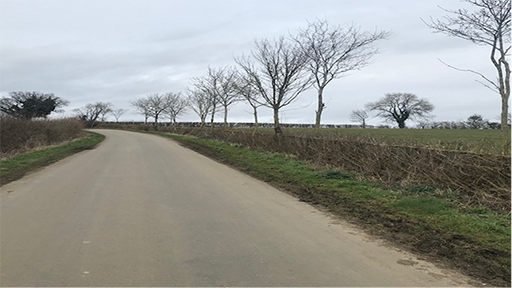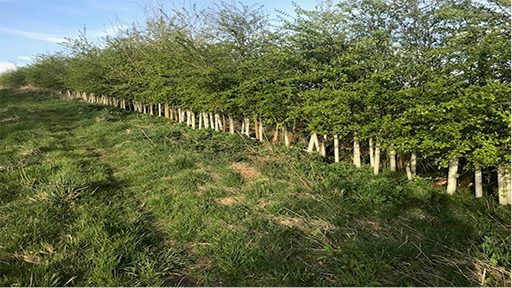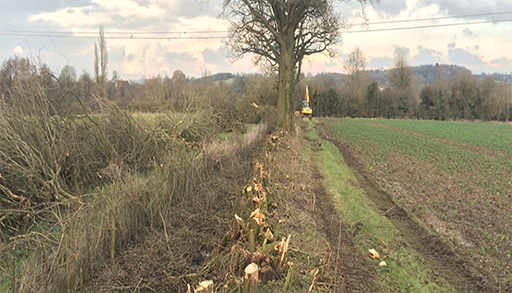Hedgerow Carbon Code
This post is greater than 6 months old - links may be broken or out of date. Proceed with caution!


With British agriculture committed to become carbon neutral by 2040 farmers are beginning to work out how the carbon accounts can be calculated for their farms. There is an array of different auditing systems which can be used to work out the greenhouse gas emissions coming from the farm, farmers just have to plug in the data including fuel and energy usage, fertilisers, feed and sprays and the system calculates the emissions. Whilst producing food requires the use of fossil fuels these can be minimised, as we have seen in the arable sector with own research at the Allerton Project, which indicates that fuel used in crop establishment can be cut by 70% by switching to non-plough tillage.
As farmers we have another inherent advantage – we are one of a very few industries that uses atmospheric carbon dioxide as an essential raw material input, locking up the carbon in plants. In crop plants this carbon sequestration is largely temporary since the carbon is released on consumption of the crop or the breakdown of residues in the soil. However plants growing outside the cropped area have the potential to lock up carbon more permanently – areas of woodland, buffer strips, beetle banks, and hedgerows all remove carbon dioxide from the atmosphere and store it in plants and soil. Over a decade ago a Woodland Carbon Code was launched enabling farmers and landowners to calculate the projected carbon storage of a newly planted wood over a one hundred year period. Being able to assign a carbon value to different habitats will enable us to better calculate the carbon credits the farm is securing outside the land used for food production, and potentially off-set the emissions from farming.

It is estimated that there are 402,000 km of hedgerows in Britain which are in good condition, with a further 145,000 km in poor condition and 26,000 km which can no longer be classified as hedges because of severe deterioration in their structure. Many of these hedges are found on former mixed farms which have reverted to all-arable production, leaving the hedges as a relic of the previous farming system, but now redundant from their role in containing livestock, yet protected by 1997 Hedgerow Regulations which require landowners to seek consent to remove hedges. It is estimated that British hedgerows are currently storing around nine million tonnes of carbon valued at £63m at base carbon prices. There is enormous potential to increase this figure by gapping up holes and allowing hedgerows to grow outwards and upwards but we need a means to calculate how much additional carbon can be stored by doing this.
To create the Hedgerow Carbon Code we turned to the Natural Environment Investment Readiness Fund (NEIRF) a grant scheme which pump-primes environmental initiatives ahead of commercialisation, administered by the Governments’ Environment Agency. The grant enabled us to bring together a small team of experts to begin working on a Hedgerow Carbon Calculator. Leading the work is Dr Matthew Axe whose PhD gained at the Royal Agricultural University focussed on hedgerow carbon. Using data gathered by “harvesting” sections of hedgerow, Data Analyst Cameron Hubbard, part of the Biometrics Team at the Game & Wildlife Conservation Trust (GWCT), was able to create a matrix to calculate the carbon in a hedge by entering the hedges dimensions; length, width and height. For hedges which are variable in structure the Calculator will allow the operator to vary the dimension data being entered in ten metre sections, although in reality the majority of hedges tend to be relatively uniform and do not require this level of resolution.

The Calculator is currently being piloted at the GWCT’s Allerton Project farm at Loddington in Leicestershire. The Allerton farm is particularly testing as the hedges have been managed for the past 30 years to benefit biodiversity and as such there are a wide range of structures and ages of hedge to measure and calculate. It is estimated that nationally 60% of hedges are made up of two principal species, hawthorn and blackthorn. Further work is needed to assess the carbon storage of other less frequently occurring species and to record the contribution to carbon storage of hedgerow trees. In order to verify the results of the Calculator drone company Treeconomy are scanning the hedge density using Light Detection and Ranging (LiDAR). Once the initial pilot is complete trials will be conducted on Kellogg’s “Origins” wheat supply chain farms in Northamptonshire. Kellogg’s are a partner in the project which we hope might ultimately lead to carbon “in-set” trading where the wheat for breakfast cereals and the carbon credits for toasting them can be traded together as a package.
Further work is also required to assess the below ground hedgerow carbon store. Initial “digs” indicate that around 40% of the hedgerow carbon is stored in the root structures and the Calculator is now able to amalgamate this with the above ground biomass. Further work led by Professor Pippa Chapman at the University of Leeds is also showing that the soil underneath hedgerows has the capacity to store considerable quantities of carbon. Professor Chapman is examining how this store of carbon varies with soil type, the age of the hedge and the previous management regime. Where hedges are cut frequently it is estimated that around 90% of the small twigs cut off by the flail fall down inside the hedge structure, ultimately landing on the soil surface. In time these become embedded within the soil, building up a substantial pool of carbon. With further research it may be possible to estimate the size of this pool and create a hedgerow soil carbon calculator.
Commenting on the Hedgerow Carbon Calculator, Project Manager Alastair Leake said, “We became concerned that the carbon agenda might eclipse the biodiversity one as farmers and landowners sought to monetise opportunities to trade carbon. What our work is showing as that there is a potential win: win with hedgerows, where both carbon storage and biodiversity can benefit simultaneously. Bigger hedges contain more carbon, but also more flowers and berries – good news for farmers and for wildlife”.
Find out more on https://www.allertontrust.org.uk/hedgerow-carbon-code
More from Game and Wildlife Conservation Trust